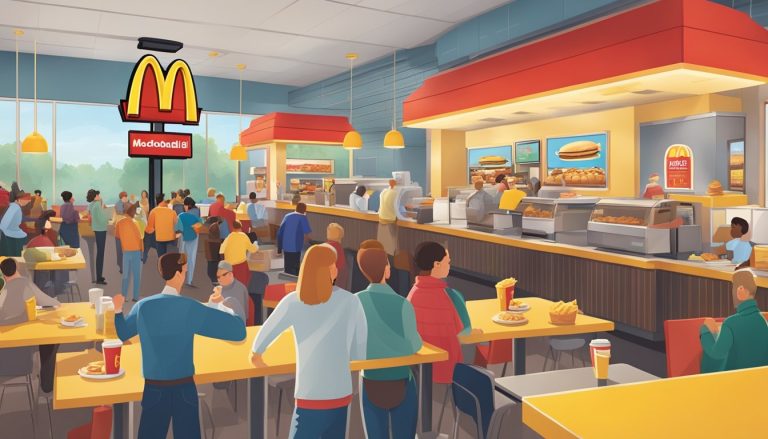McDonald’s breakfast has been a staple of American fast food culture since its introduction in 1972. Over the years, it has adapted to changing consumer preferences and lifestyles. The fast food giant’s breakfast menu has evolved from a morning-only offering to a more flexible option, reflecting shifts in morning commute habits and dining patterns.
McDonald’s decision to offer all-day breakfast in 2015 was a response to changing work schedules and consumer demands for greater meal flexibility. This move allowed customers to enjoy breakfast items beyond traditional morning hours, catering to late risers, shift workers, and those with non-traditional schedules. The expansion of breakfast hours also aligned with broader trends in the fast food industry, as competitors rushed to capture a larger share of the breakfast market.
Recent data suggests that McDonald’s customers are increasingly visiting the restaurant later in the day. In 2023, 21.2% of McDonald’s customers visited between 7 p.m. and 10 p.m., up from 18.8% in 2019. This shift in dining patterns may reflect changes in work habits, including remote work arrangements and flexible schedules, which have altered traditional morning commute routines and breakfast consumption habits.
The Evolution of Breakfast at McDonald’s
McDonald’s transformed the fast food breakfast landscape through innovative menu offerings and expanded service hours. The company’s breakfast journey spans decades of menu development and adaptations to changing consumer preferences.
Historical Breakfast Milestones
McDonald’s ventured into breakfast in 1972 with the introduction of the Egg McMuffin. This iconic sandwich, created by franchise owner Herb Peterson, laid the foundation for the chain’s morning menu. In 1977, McDonald’s officially launched its breakfast menu nationwide, featuring items like hotcakes, toasted English muffins, and scrambled eggs.
The menu expanded over time to include popular choices such as the Sausage McMuffin and hash browns. These additions helped solidify McDonald’s position as a go-to destination for quick, convenient breakfast options.
Introduction of the All-Day Breakfast
In October 2015, McDonald’s made a groundbreaking move by introducing all-day breakfast across its U.S. locations. This decision marked a significant shift in the fast food industry, breaking the traditional time constraints on breakfast service.
The all-day breakfast menu initially included a selection of popular items like the Egg McMuffin, hotcakes, and hash browns. This change allowed customers to enjoy their favorite breakfast items at any time, increasing sales and customer satisfaction.
The introduction of all-day breakfast required operational adjustments but proved successful in attracting new customers and boosting overall sales. It demonstrated McDonald’s ability to adapt to changing consumer demands and maintain its competitive edge in the fast food market.
Consumer Behavior and Breakfast Options
Consumer preferences for breakfast have evolved significantly in recent years. Eating habits and demand for breakfast items have been shaped by changing lifestyles and external factors like the pandemic.
Impact of the Pandemic on Eating Habits
The COVID-19 pandemic disrupted traditional morning routines. With remote work becoming prevalent, many people shifted their breakfast patterns. Some opted for later breakfasts, while others incorporated more home-cooked meals.
McDonald’s saw changes in customer traffic. Data shows a 21.2% increase in evening visits from 7 p.m. to 10 p.m. in 2023, compared to 18.8% in 2019.
This shift reflects broader trends of people reverting to pre-pandemic habits, including commuting to offices and dining out more frequently.
Changing Demand for Breakfast Items
Consumer demand for breakfast options has expanded beyond traditional morning hours. McDonald’s responded to this trend by introducing All-Day Breakfast in October 2015.
This move marked a significant shift in the fast-food industry, challenging operational norms and meal-time conventions. It allowed customers to enjoy breakfast items at any time of day, catering to diverse schedules and cravings.
The popularity of all-day breakfast options indicates a growing consumer desire for flexibility in meal choices.
Diverse Breakfast Menus Catering to Customer Preferences
Fast-food chains have adapted their menus to meet evolving customer preferences. McDonald’s has introduced innovations in its breakfast offerings, including:
- Enhanced beverage options
- Healthier alternatives
- Digital ordering conveniences
These changes reflect a broader industry trend towards healthier eating and digital accessibility. Chains now offer a wider variety of breakfast items to cater to different dietary needs and taste preferences.
Menu diversity has become crucial in attracting and retaining customers in a competitive breakfast market.
Operations and Supply Chain Dynamics
McDonald’s has adapted its operations and supply chain to meet changing breakfast demands. The company has implemented strategic changes to its restaurant processes and ingredient sourcing to maintain efficiency and quality.
Adapting Restaurant Operations to New Trends
McDonald’s redesigned kitchen layouts to accommodate all-day breakfast preparation. New equipment installations allow simultaneous cooking of breakfast and lunch items. Staff training programs focus on multitasking skills to handle diverse menu offerings throughout the day. Digital ordering systems streamline the process, reducing wait times during peak hours.
Menu simplification efforts help balance variety with operational efficiency. McDonald’s trimmed less popular items to focus on core breakfast favorites. This strategy optimizes kitchen workflows and inventory management.
Efficiency in the Breakfast Supply Chain
McDonald’s leverages its vast supplier network to ensure consistent ingredient quality and availability. The company works closely with egg and meat suppliers to meet increased demand for breakfast items. Regional distribution centers coordinate just-in-time deliveries to minimize food waste and maintain freshness.
Forecasting tools analyze sales data and consumer trends to predict ingredient needs. This proactive approach helps prevent stockouts and overordering. McDonald’s also invests in sustainable sourcing practices, partnering with suppliers who meet specific environmental and ethical standards.
Temperature-controlled transportation ensures ingredients arrive in optimal condition. Advanced inventory management systems track stock levels in real-time, triggering automatic reordering when necessary.
Technological Advances and Breakfast Service

McDonald’s has leveraged digital technology to enhance its breakfast service and adapt to changing customer habits. Mobile ordering and flexible hours have reshaped how people interact with fast food breakfast options.
Integration of Mobile Ordering with Morning Routines
McDonald’s mobile app allows customers to order breakfast items with ease. Users can customize their meals, skip lines, and schedule pickup times that fit their schedules. This technology has streamlined the breakfast experience for busy commuters.
The app also offers exclusive deals and promotions, incentivizing customers to choose McDonald’s for their morning meals. Mobile ordering has reduced wait times and improved order accuracy, addressing common pain points in fast food service.
Data from mobile orders helps McDonald’s optimize its breakfast menu and inventory management. The company can track popular items and adjust stock levels accordingly, reducing waste and improving efficiency.
Foot Traffic and Breakfast Hours
McDonald’s has adjusted its breakfast hours in response to changing foot traffic patterns. Many locations now serve breakfast until 11 AM, extending availability for late risers and shift workers.
This extension has impacted foot traffic distribution throughout the morning. The traditional breakfast rush has spread out, with more customers visiting during mid-morning hours.
Digital kiosks in restaurants have further altered foot traffic flow. These self-service stations reduce queues and allow customers to browse the full breakfast menu at their own pace.
McDonald’s has also experimented with 24-hour breakfast at select locations. This move caters to night shift workers and early morning commuters, tapping into previously underserved markets.
Analyzing McDonald’s Place in the Fast-Food Industry
McDonald’s dominates the fast-food breakfast market through its diverse menu and extensive franchise network. The company’s strategic focus on morning offerings has solidified its position as a breakfast leader.
Competing Breakfast Offerings
McDonald’s breakfast menu features iconic items like the McGriddle and Sausage Biscuits. These offerings compete directly with other fast-food chains and coffee shops. The company’s Hash Browns have become a staple side dish, often paired with breakfast sandwiches.
McDonald’s faces competition from Starbucks and other chains that have expanded their breakfast options. To maintain its edge, McDonald’s continually innovates its menu and improves food quality.
The Role of Franchisees in Breakfast Success
Franchisees play a crucial role in McDonald’s breakfast success. They manage local operations and implement corporate strategies at the store level. Franchisees often provide valuable feedback on menu items and customer preferences.
These independent operators are responsible for maintaining consistent quality and service standards across locations. Their local knowledge helps tailor breakfast offerings to regional tastes.
Franchisees also contribute to marketing efforts and community engagement, which are essential for building customer loyalty in the competitive breakfast market.
Customer Satisfaction and Brand Loyalty
McDonald’s breakfast offerings have played a crucial role in shaping customer satisfaction and fostering brand loyalty. The expansion of breakfast menus and increased availability have impacted consumer preferences and dining habits.
Case Studies of Successful Breakfast Menus
McDonald’s Egg McMuffin, introduced in 1972, revolutionized fast-food breakfast. This iconic item helped establish McDonald’s as a morning destination. The McCafé line, launched in 2009, further expanded breakfast options and attracted new customers.
In 2015, McDonald’s introduced All-Day Breakfast, responding to consumer demand for greater flexibility. This move boosted sales and customer satisfaction. A study by NPD Group found that 30% of customers who purchased breakfast items outside traditional morning hours were new or lapsed McDonald’s customers.
The success of items like the McGriddles and breakfast burritos demonstrated McDonald’s ability to innovate while maintaining familiar flavors. These offerings helped solidify the brand’s position in the competitive breakfast market.
Analyzing the Impact of Breakfast Options on Customer Loyalty
Breakfast availability has significantly influenced customer loyalty at McDonald’s. A survey conducted in 2019 revealed that 64% of regular McDonald’s customers cited breakfast options as a key factor in their brand loyalty.
McDonald’s focus on breakfast quality has also contributed to customer satisfaction. The use of freshly cracked eggs and premium coffee beans in McCafé products has improved perception of the overall brand.
• 72% of customers reported higher satisfaction with McDonald’s after the introduction of All-Day Breakfast
• 45% increase in breakfast-related visits among millennials since 2015
• 3.5% rise in customer retention rate attributed to expanded breakfast offerings
The convenience of mobile ordering and delivery for breakfast items has further enhanced customer loyalty. This integration of technology with traditional breakfast fare has helped McDonald’s adapt to changing consumer habits and maintain its competitive edge.




